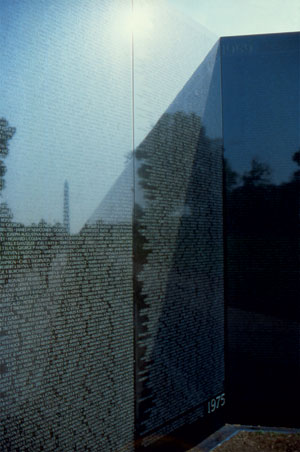A Place to Mourn, Individually and as a Nation
A controversial design honoring the lives lost in a controversial war, the Vietnam Veterans Memorial today stands as a nearly universally admired landmark. We still debate the war itself, but almost everyone agrees that Maya Lin’s graceful, abstract monument touches people in a direct and profound way. While designing the project for a class during her senior year at Yale, Lin “always thought of the individual visiting it, the one-on-one experience,” she recalled in a recent phone interview. She has been surprised, though, at how the memorial has become part of the nation’s collective consciousness, a touchstone for people of widely different backgrounds and political views.
The project’s early critics called it a scar, and in her 2000 book, Boundaries, Lin herself wrote, “I imagined taking a knife and cutting into the earth, opening it up, an initial violence and pain that in time would heal.” But she now explains, “It is not a scar, but an interface, a thin boundary line, between two worlds.” The monument’s polished black granite surface, into which the names of 57,000 dead or missing Americans are engraved, reflects the images of the people who approach it. The living see themselves in the names of the fallen. “We can’t enter that world. We have to turn around and go back to the light,” she says.
Listing all the names of those lost in the war was required by the rules of the design competition (which attracted more than 1,400 entries). One of Lin’s seemingly odd, but ultimately key, decisions was to list the names not alphabetically, but in the order in which they died. This strategy requires visitors to consult a map to locate the name of a loved one, but places the fallen among those they died with—a powerful mnemonic for veterans who see the names of comrades together.
Today the memorial seems so logical, such a natural fit with its setting. But it was a radical design in 1982, when most people thought of monuments as figurative sculptures or vertical (read phallic) markers. Lin’s scheme changed our basic notion of what a memorial is, speaking a language everyone understands.



Post a comment to this article
Report Abusive Comment